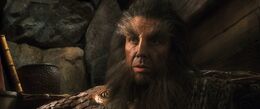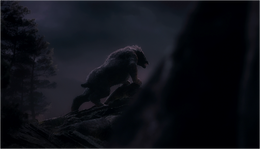- "If you must know more, his name is Beorn. He is very strong, and he is a skin-changer."
- —Gandalf the Grey [1]
Beorn was a Northman, a Shape-shifter, and a Beorning chieftain. Beorn's kin once inhabited the North of the Anduin valley between the Misty Mountains and Mirkwood during the last centuries of the Third Age. They guarded the Ford of Carrock from the Goblins and Wargs.[1]
Biography
Third Age
Beorn was a warrior with great strength, who could turn into a great black bear. In human form, he appears as a tall, black-haired man with huge arms and a great beard. Beorn kept many animals at his residence, such as horses and dogs. His animals were all extremely intelligent; his dogs, for instance, could walk on their hind legs while carrying things with their forelegs, set the table, and able to speak. Beorn's horses could also understand what their master said. Beorn was also capable of speaking in the tongue of beasts, as he could communicate with bears. When he spoke to his dogs, his words sounded like barks twisted into some form of speech.[1]
The Quest to Erebor

Beorn chases the Dwarves.
Beorn provided shelter to Thorin Oakenshield and his Company of Dwarves (12 others), Hobbit (Bilbo Baggins), and Wizard (Gandalf), and later helped them fight against an army of Goblins at the Battle of the Five Armies on November 23, 2941.
During the Battle of the Five Armies, Beorn arrives in his bear form, and kills the Goblin chieftain Bolg.[2] After the battle, Beorn accompanied Gandalf and Bilbo through their journey home until he reached his house.[3]
Before the War of the Ring, Beorn passed away,[4] and his son Grimbeorn eventually took over his duties as chieftain in TA 3018.[5]
Etymology
The name Beorn originates from Old English which means "warrior" . It is a cognate to the Old Norse bjǫrn which means "bear".[6]
Character
Despite being incredibly powerful, Beorn respects all life forms, with the absolute exception of Goblins. He has sorcerer-like effects on animals, who seemed to more intelligent and strong then other animals. He keeps bee pastures and spends his nights patrolling the woods and mountains in the form of a bear. He is wise, mysterious and powerful, possessing incredible strength and durability. He is fairly decent, as he allows Thorin and Company to stay at his home for a short while and even offers them sanctuary from the Goblins. He is also vengeful. When Thorin is fatally wounded, he storms the Goblin ranks, rescues Thorin and then returns, destroying the Goblins and killing Bolg himself.
Portrayal in adaptations
The Hobbit film trilogy

Beorn in his human form.
Beorn is portrayed by Mikael Persbrandt in the films The Desolation of Smaug and The Battle of the Five Armies. His appearance in the films is quite different than his description in the book and portrayals in other media. In the films, he has greyish-brown hair, a forked beard, shackles on his left arm, and a mane of hair growing as a ridge down the length of his back. Beorn mentioned his fellow Shape Shifters, who once lived in the mountains before Azog the Defiler came down from the north and killed or enslaved many of his people for sport. Beorn escaped the terrible fate of his kin (explaining the shackles on his arm), and claims that he is the last of their kind. He gives them horses to reach Mirkwood and provides escort to protect them from roaming Orcs. Beorn appears to be aware of the dark presence in Dol Guldur as he knows of an alliance between the Orcs of Moria and the Necromancer, whom he calls the Sorcerer, in Dol Guldur. Packs of Orcs have been seen gathering in the fortress with their numbers increasing every day. Beorn also knows that the Necromancer is not what he seems to be and that dark and foul things are drawn to his power, not to mention Azog's allegiance to him. He also heard word spread of the dead rising and walking near the High Fells of Rhudaur. He asked Gandalf if there actually were tombs in those mountains and Gandalf confirms the tombs as Beorn remembered a time when a great evil ruled the lands and had the power to raise the dead. If that evil had returned, he wished to know from Gandalf.
In The Battle of the Five Armies, he makes a brief cameo during the battle, shifting from man to bear form as he arrives with the Great Eagles, attacking several goblins and wargs.

Beorn watches Azog's forces.
Beorn's personality is notably different from what it is in the book. Instead of being boisterous and impatient, Beorn is depicted as soft-spoken and collected. Beorn is also said to be in little control of himself in the The Desolation of Smaug, but in the book, he can be tame and gentle as a bear, even following the Dwarves to ensure the return of his ponies when the Dwarves leave his house to go to Mirkwood.
Voice Dubbing actors
| Foreign Language | Voice dubbing artist |
|---|---|
| Portuguese (Brazil) (Television/DVD) | Bruno Rocha |
| Spanish (Latin America) | Octavio Rojas |
| Spanish (Spain) | Ricky Coello |
| Italian (Italy) | Paolo Marchese |
| German | David Nathan |
| Polish | Zbigniew Konopka |
| Czech | Miloš Vávra |
Translations around the World
| Foreign Language | Translated name |
|---|---|
| Chinese (Hong Kong) | 比翁 |
Trivia
- In the early film concepts, his bear form was rather monstrous, looking more likely that of a Troll or an Orc.
- At one point in film development, he was set to play a part in the Dol Guldur storyline, as was speculated from his appearance in a LEGO set, 79011 Dol Guldur Ambush.
Gallery
 |
 |
 |
 |
 |
 |
| File:Beorn.png |
| File:Beorn1.jpg |
References
- ↑ 1.0 1.1 1.2 The Hobbit, Chapter VII: "Queer Lodgings"
- ↑ The Hobbit, Chapter XVII: "The Clouds Burst"
- ↑ The Hobbit, Chapter XVIII: "The Return Journey"
- ↑ The Letters of J.R.R. Tolkien, Letter 144, (dated 25 April 1954)
- ↑ The Lord of the Rings, The Fellowship of the Ring, Book Two, Chapter II: "The Council of Elrond"
- ↑ The History of Middle-earth, Vol. 1: The Book of Lost Tales Part One, I: "The Cottage of Lost Play"
